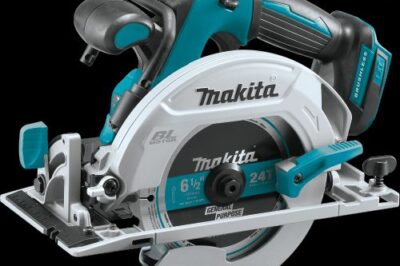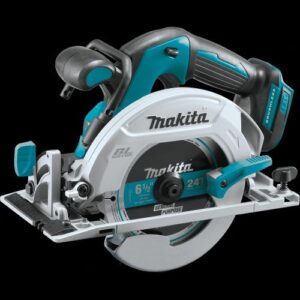Key Takeaways
-
Makita XSH03Z and Dewalt DCS391B are two top contenders for the quietest circular saws available.
-
Both saws feature brushless motors, which contribute to their low noise levels.
-
They offer different battery voltages, with the Makita at 18V and the Dewalt at 20V.
-
Considering noise, power, and user comfort is crucial when selecting a circular saw.
Key Features That Make a Circular Saw Quiet
-
Brushless Motor: As mentioned, brushless motors are quieter than their brushed counterparts.
-
Anti-Vibration Technology: Some saws come with built-in tech to dampen vibration, which in turn reduces noise.
-
Soft Start: A saw that ramps up to speed gradually will be quieter than one that jumps to full speed instantly.
-
Blade Design: Blades with specific tooth designs or laser-cut stabilizer vents can cut down on noise.
Makita XSH03Z: The Silent Cutter
Technical Specifications and Design
-
Voltage: 18V
-
No-Load Speed: 5,000 RPM
-
Blade Diameter: 6-1/2 inches
-
Maximum Cutting Depth: 2-1/4 inches at 90 degrees
This saw runs on Makita’s 18V LXT® Lithium-Ion battery, which provides plenty of power for most cutting tasks. The brushless motor is engineered for efficiency, allowing for longer run time, increased power and speed, and longer tool life.
User-Friendly Features and Safety Enhancements
The Makita XSH03Z isn’t just about power; it’s also about precision and safety. It features:
-
An electric brake for increased productivity.
-
A built-in dust blower to keep the line of cut free of debris.
-
Dual LED lights to illuminate the work area.
These features not only make your work safer but also more accurate. The less time you spend clearing away sawdust or squinting at your cut line, the more time you can spend actually cutting.
Most importantly, the Makita XSH03Z is designed with Extreme Protection Technology (XPT™), which is engineered for improved dust and water resistance for operation in harsh conditions. This means that even when you’re cutting in less than ideal environments, your saw is protected.
Dewalt DCS391B: Power Meets Stealth
The Dewalt DCS391B steps up to the plate with its own set of features that make it a worthy competitor in the quiet circular saw arena. Known for robust construction and reliability, Dewalt’s offering is designed to tackle a range of cutting jobs without making a racket.
Technical Specifications and Design
Dewalt’s DCS391B is a cordless circular saw that promises power and precision. Here are its core specs:
-
Voltage: 20V
-
No-Load Speed: 5,250 RPM
-
Blade Diameter: 6-1/2 inches
-
Maximum Cutting Depth: 2-1/4 inches at 90 degrees
Advanced Features and Ergonomic Design
The Dewalt DCS391B isn’t just about brute force; it also comes with features that enhance its usability:
-
An over-molded comfort grip that delivers optimal balance and control.
-
A high-strength and lightweight magnesium shoe provides job site durability for long-term cut accuracy.
-
A 0-50 degree bevel capacity allows for aggressive bevel cuts for a multitude of applications.
These features are designed to make the saw easy to handle and maneuver, which is crucial when you’re working on precise cuts or dealing with tough materials. The ergonomic design also means you can work longer with less strain on your hands and arms.
Head-to-Head: Makita XSH03Z vs Dewalt DCS391B
Comparing Cutting Power and Performance
Both the Makita XSH03Z and the Dewalt DCS391B boast impressive specs, but they do have some differences. The Makita’s 18V battery is slightly less powerful than the Dewalt’s 20V, but in practice, the difference in cutting power is often negligible. What’s more important is how the saw feels in your hands and how it performs on the materials you’re cutting most often.
Noise Levels: Which Saw Really Cuts Quieter?
When it comes to noise, both saws are designed to be quieter than traditional circular saws, thanks to their brushless motors. However, the Makita XSH03Z is often noted for its especially quiet operation. While the Dewalt DCS391B is no slouch in the stealth department, the Makita might be the better choice if you’re particularly sensitive to noise.
Durability and Longevity in Professional Use
Durability is a key factor for any tool that’s going to see heavy use, and both Makita and Dewalt have solid reputations in this regard. The Makita XSH03Z’s XPT™ technology gives it an edge, while the Dewalt DCS391B’s rugged construction means it can take a beating and keep on cutting.
Ease of Use and User Comfort
Both saws score highly on ergonomics, with comfortable grips and balanced designs that make them easy to handle. The Dewalt’s over-molded grip is particularly noteworthy for its comfort during extended use. The Makita’s lightweight design, on the other hand, reduces fatigue, which can be a significant advantage on long jobs.
Choosing between these two saws might come down to personal preference or brand loyalty. Both are excellent choices for anyone looking for a quiet, reliable, and powerful circular saw.
FAQs About Quiet Circular Saws
What Makes a Circular Saw Quiet?
Several factors contribute to the noise level of a circular saw:
-
The motor type: Brushless motors are typically quieter than brushed ones.
-
Blade design: Thinner blades with more teeth tend to be quieter.
-
Build quality: A well-constructed saw with tight fittings and dampening features will usually operate more quietly.
Can You Retrofit an Existing Saw to Make It Quieter?
While it’s tough to make a significant impact on the noise level of an existing saw, there are a few things you can do:
-
Ensure the saw is well-maintained and lubricated.
-
Use a higher-quality, quieter blade.
-
Install anti-vibration clamps or handles.
However, these tweaks will only go so far. If quiet operation is a priority for you, investing in a saw designed to be quiet from the ground up is often the better choice.
How Does Blade Size Affect Noise Levels?
Generally, larger blades will produce more noise due to the increased cutting area and potentially higher speeds. However, blade quality and design can mitigate this. For example, a well-designed 7-1/4 inch blade could be quieter than a poorly designed 6-1/2 inch blade.
Is a Brushless Motor Really Quieter Than a Brushed One?
Yes, brushless motors tend to be quieter. They have fewer moving parts, which means less friction and noise. Plus, they’re more efficient, which translates to less strain on the motor and, therefore, less noise.



